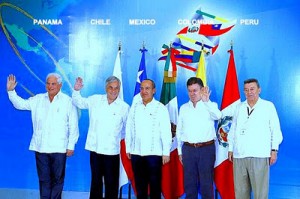Latin America’s Pacific Alliance Plans for 2012
During the Second Pacific Alliance Summit on December 4, 2011, held in Mérida, Mexico, the Heads of State of Mexico, Chile, Colombia, and Peru took a significant step towards the formation of what could turn out to be an unprecedented trading alliance, inspired by the July 28, 2011 Presidential Declaration of Lima .
In its initial period, the coalition will consist of the aforementioned countries. However, the current members are encouraging additional Latin America countries to join once they meet the essential requirements, which are: the recognition of the validity of the rule of law and the respective constitutional orders, the separation of branches of government, and protection of and respect for human rights and fundamental freedoms. Panama’s President Ricardo Martinelli participated in the summit as an observer, indicating the country’s interest in joining the trade alliance, although the Panamanian president would find it difficult to qualify as a hard-core democrat.
According to Mexican President Felipe Calderón, the allied countries combined represent a population of 200 million, fifty percent of Latin America’s imports and exports, and over thirty-four percent of the region’s Gross National Product (GNP). In addition, the president mentioned that the association would surpass the trade volume of the Common Southern Market (Mercosur).
Despite the fact that the Pacific Alliance Summit includes social and environmental objectives, the agreement will mainly focus on regional economic integration centered on the movement of people and the trading of goods, capital and technology. Unlike Mercosur, the social, educational, and cultural aspects of the union will be a secondary consequence of the Alliance. As a result their intense economic focus, members seek to enhance their business competitiveness, development, job generation, as well as overall economic growth.
According to the press release sent out after the summit was concluded, the countries signed two memorandums of understanding creating the Pacific Cooperation Platform and the Mixed Joint Comity, in order to, respectively, promote collaboration regarding issues of their common interest and support services, attracting new investments, including the analysis of existing measures regarding the treatment of foreign investments in each country.
Also, they commit to sign the treaty to establish the Pacific Alliance within a period of not more than six months and to create a Pacific Alliance visa within a period of three months seeking to facilitate the entry of businesspeople in the allied countries.
Additionally, the signatory countries began to compile a strategy to work on technical obstacles related to trading, such as transparency, and the regulatory functions, among others, that will be faced in 2012. Nevertheless, the members confirmed their commitment to construct an effective mechanism of political dialogue and negotiation with the Asia Pacific region.
The foundation of the Pacific Alliance is undoubtedly a clever move by these countries to protect themselves from the baleful effects of the European crisis by uniting some of the most prosperous developing countries in the world and potentially, outflanking Mercosur in its importance. In addition, the Pacific Alliance is likely to strongly benefit its members, since their geographic location gives them advantage in trade with Asian Pacific countries, which is among their most sought-after goals. Nevertheless, all of the countries involved will continue with their links to other current American trading coalitions, such as the North American Free Trade Agreement (NAFTA), the Asia-Pacific Economic Cooperation (APEC) and the Andean Community of Nations (Comunidad Andina – CAN), further fortifying their ever-growing economic formidability. On the other hand, there is no guarantee the coalition might not generate political disaffection with major countries not included in this summit. In that case, the Pacific Alliance could negatively affect the nature that the membership might have with parallel trading blocs.


